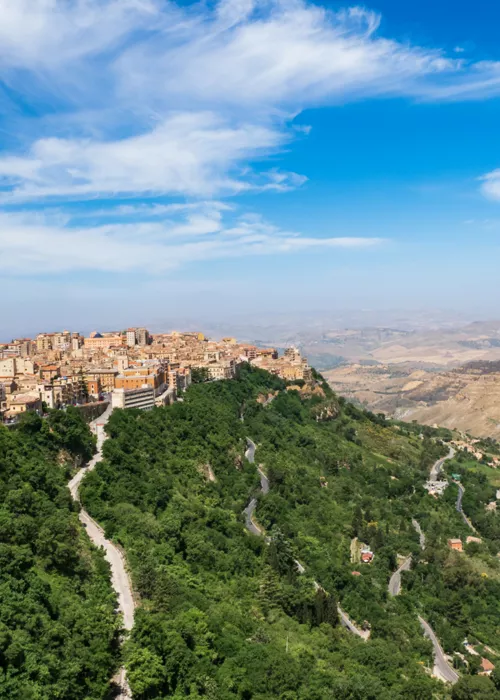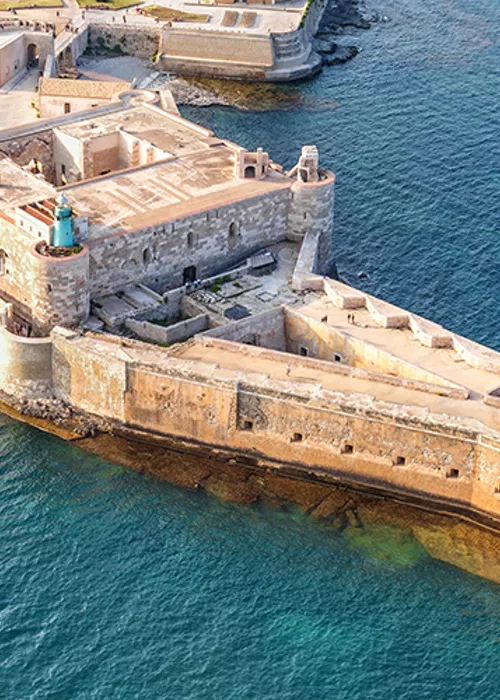Piazza Armerina

It might seem strange that Leonardo Sciascia, one of the greatest writers of the 20th century in Italy, placed Piazza Armerina among 'the Lombard towns of Sicily' next to Enna with its Castle of Lombardy', and Caltagirone, which marks its town hall with the coat of arms of Genoa', but indeed the century of Norman domination had moved many settlers here from northern Italy and some traces of this process can still be recognised.
Today, however, the heart of the city at the foot of the Erei mountains is vibrantly Sicilian: streets to wander aimlessly between medieval quarters and beautiful churches, savouring every step to discover the life and history carved in every stone and reaching, on the way up, to the Duomo which, located in the highest part of the city, dominates the whole town. Heir to the ancient 14th-century church, the cathedral was rebuilt between the 17th and 18th centuries on the wishes of Baron Marco Trigona, owner of Palazzo Trigona, now the City and Region Museum. Certainly worth a visit is the Aragonese Castle, built in the late 14th century to protect an historic centre full of charm and embellished by the presence of medieval military orders, such as the Knights of Malta and the legendary Templars.
Inevitable is a visit to the Roman Villa del Casale, with its beautiful mosaics and structures immersed in the silence of the countryside. A short distance away, but even more surrounded by nature, is the Floristella Grottacalda Mining Park, witness to the fervent mining activity of the great nineteenth-twentieth-century sulphur mines.
Villa Romana del Casale

"Exceptional quality, magnificence and perfect state of conservation": these are the reasons that led Unesco to recognise the cycle of mosaics of the Villa del Casale as a World Heritage Site in 1997.
Beautiful hunting scenes are flanked by scenes of daily life and vegetable decorations in a unique way that is amazing for its completeness and highlights the importance of the owner who knew how to convene artists from North Africa to take care of the decoration of his villa.
Definitely well-known is the image of the 'ten girls in bikinis', the ten athletes, mostly trying to lift weights, throw a puck or play ball.
The rustic villa of the Casale, built at the end of the 4th century AD, testifies to the importance of these territories in the agricultural and pastoral field. A tradition that over the centuries has been enriched also thanks to the numerous overlaps of peoples and cultures, also giving the cuisine those typically Sicilian Mediterranean characteristics.
You certainly cannot leave Piazza Armerina without having enjoyed a good apéritif, perhaps sitting in one of the many places in the historic centre and savouring a Piacentinu Ennese accompanied by a good glass of Sicilia DOC red wine.
Caltagirone

The approximately thirty kilometres that separate Piazza Armerina from Caltagirone cross characteristic stretches of prickly pears near San Michele di Ganzaria. Then there are agaves, dry stone walls, farmhouses and farms not always in use, palm trees, pines and eucalyptus trees, but above all olive trees, the plants that most speak of this Sicily of the East. The large olive trees, the twisted and knotty ones that have survived history, are here called "Saracens" and tell, in the name, another piece of the beautiful mosaic that is Sicily: Greeks, Phoenicians, Romans, Byzantines, Arabs, Normans, Genoese, Piedmontese, Spaniards...
Caltagirone is a historic centre protected byUnesco for the quality of its baroque architecture, which was rebuilt after the 1693 earthquake. Above all, however, it is the city of ceramics: colourful majolica reigns among parades of shops with plates, vases, lamp holders, ashtrays, candelabras, fruit holders, salt shakers, angels and kittens. Everything is ceramic, from the small votive kiosks to the rises of the dizzying staircase of St Maria del Monte.
Only fifteen kilometres further east, the square of Grammichele is not only a perfect hexagon: it is also an area closed to traffic, where walking really means breathing.
We have now left behind the Erii of Piazza Armerina, to enter the Iblei mountains. After taking the road to Vizzini, the city of Giovanni Verga and the literary heart of this Sicily, continue to Palazzolo Acreide.
Palazzolo Acreide

South of Vizzini, the path shows the Iblei mountains, with wooded plateaus, boulders, ancient olive groves, pastures swept by the winds, wind blades that stand out on the horizon and create a harmonious counterpoint with the dammusi, the typical stone buildings that dot the landscape with an Arabian flavour. You can decide to take the detour to the left for Buscemi, a suspended town and almost a museum town, or continue in the unreal silence of a Sicily that slides towards Palazzolo Acreide.
Also in Palazzolo, the third Unesco site in this part of Sicily, the earthquake of the late seventeenth century favoured a flowering of the Baroque, as evidenced by the main church of San Sebastiano and the basilica of San Paolo. Among buildings, streets and ceramics there is much to see, but if you want to capture a little more of Sicily you cannot fail to go to the museum housethat Antonino Uccello, an Italian anthropologist of the twentieth century, wanted to create as a real place of the ethnographic memory of the island, to recover the cultural heritage of peasant and rural Sicily threatened by the dispersion deriving from an ever-increasing migratory flow towards the northern regions.
Noto

Driving from Palazzolo Acreide towards Noto, about forty kilometres in all, you leave the mountainous landscape to meet a plain, a large pasture, animals that graze, rural farmhouses, infinite stone walls. The road narrows again, introducing another landscape characterised by the lush vegetation that surrounds the Manghisi stream, the ideal habitat of the macrostigma trout, the ancient Mediterranean salmonid.
You can deviate to the provincial road that leads briefly to the Noto Antica, in existence until the 1693 earthquake that forced the town to be rebuilt further south. In the silence of the ruins, you can see the remains of a Cistercian monastery: it was the ancient abbey of Santa Maria dell'Arco rebuilt in new forms, in the modern Noto. The state road follows the rocky outlines and, crossing a large canyon, leads to the San Chiara bridge. The eye is lost along the road, between the dry walls and the villas overlooking the cliff.
The route crossed the provinces of Enna, Catania and Syracuse, passing from the Erei mountains to the Iblei and beyond. Now you take your breath away in front of the splendour of Noto Cathedral and the slow, fragrant, endless breath of the historic centre of this magnificent city, the heart of Sicilian Baroque and a UNESCO World Heritage Site.
Portopalo di Capo Passero

From Noto towards the southernmost tip of Sicily, the landscape changes once again: the yellow and orange of the citrus groves that garden together with the olive trees suddenly emerge and tell us a poetry that, more than Italian, is intensely Mediterranean. Along the way we meet the old Noto-Pachino railway, long abandoned, now the subject of an important recovery project for tourism purposes. The line, which once served to transport wine from the Pachinese and fish from the port of Marzamemi, will become a real tourist attraction: its intermediate section, in fact, entering the Vendicari Wildlife Oasis Oriented Nature Reserve will allow the visitor to enjoy the protected area in a unique way. We cannot leave this corner of Sicily without having visited the city of Pachino and the coastal town of Marzamemi.
Enchanted places of art, culture and traditions: archaeological sites, ancient watchtowers and monumental tunnels. A land coveted and inhabited since antiquity, which has heard every language of our beautiful Mediterranean spoken on its soil. Many peoples and many cultures that have left, even in the local cuisine, the most varied influences of which the Pachino PGI tomato is just one of the last.
Let's head to the coast to reach Portopalo and its magnificent sea.
The view of the Mediterranean is a tug at the heartstrings, recounting the dreams of the lost lives of migrants but also of the now ended fortunes of the local aristocracy: the so-called Tafuri castle, an Art Nouveau building commissioned in the early 1900s by the owners of the Capo Passero tuna fishery, is now a bed & breakfast.
Beaches, boat excursions, mask and snorkel hire, the sea at Capo Passero is still dreamlike and not just tourist rhetoric to describe as crystal clear.
Our journey is coming to an end. We head towards the southernmost tip of Sicily and begin to see the sea in the distance. As we approach our destination, we finally see the Island of Correnti with its lighthouse emerging from the Ionian Sea. The small stretch of land at low tide is attached to the mainland and is the southernmost point of the Sicilian island, geographically further south than Tunis and further north than Hammamet.
















